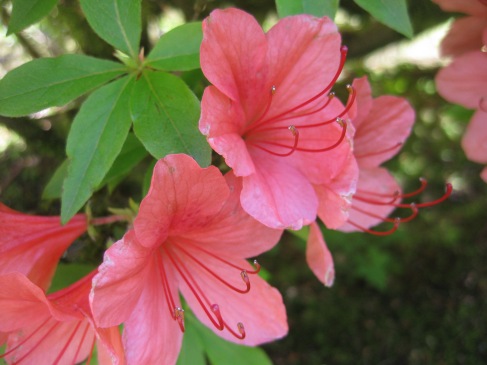Rhododendron Rhododendron / Azalea • シャクナゲ / ツツジ • 石楠花 / 躑躅 shakunage / tsutsuji
SJG has them growing in many areas and they command attention mid-spring for their fiery colors (ours are mostly orange) and dense habit of flower growth. If you ever sit on the bench in area F between the two shortcuts along the E path you can see several of them placed near the water edge.
Rosebay (American Rhododendron Society Massachusetts Chapter) has this informative article written on the topic by Sally Perkins of Salem, NH: Rhododendron kaempferi is commonly called the Torch or Kaempfer azalea; in Japan it is called ‘Yama Tsutsuji’. R. kaempferi is in the subgenus Tsutsusi, a large section of evergreen azalea species. It is the most common azalea of Japan being found from the southern island of Kyushu to the northern island of Hokkaido from sea level to 4000 feet (1200 m) elevation. At home on volcanic slopes, open shrubland and in mixed deciduous forests this evergreen azalea is an upright growing shrub to 8 feet (3 m) in height.
Like many evergreen azaleas it produces 2 kinds of leaves, spring leaves and summer leaves. It is the summer leaves that will survive the winter, with the spring leaves being deciduous. The spring leaves are narrowly lance-shaped 1-1.5 inch (2-3 cm) long with ciliated margins and scattered bristles on the upper and lower surfaces. The smaller summer leaves 1/4 to 3/4 inch (1 to 1.8 cm) long are similarly hairy and clustered around the terminal bud. The young shoots are covered with adpressed flattened chestnut-brown hairs. […]
Although the red flower is considered the typed specimen there are lovely salmon colors in northern Japan described as Latisepalum Group. Pink and white flower forms have also been selected from the wild. Natural hybrids with R. kiusianum occur wherever their habitats overlap. In fact, E. H. Wilson described a continuum of kaempferi and kiusianum hybrids as he explored one mountain in Japan. […]
tagged



